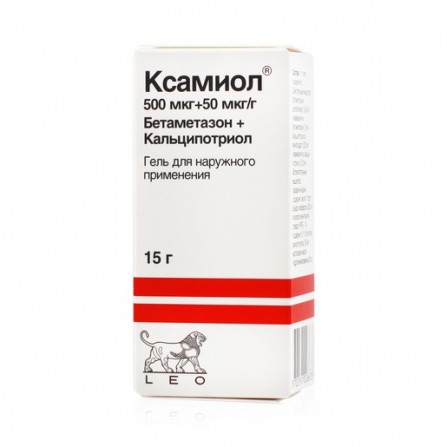Xamiol gel for external use 15g
Condition: New product
1000 Items
Rating:
Be the first to write a review!

More info
Active ingredients
Betamethasone + Calcipotriol
Release form
Gel
Composition
1 g of betamethasone dipropionate 643 mcg, equivalent to betamethasone 500 mcg calcipotriol monohydrate 52 mcg, equivalent to calcipotriol 50 mcg. Excipients: liquid paraffin 820 mg, polypropylene glycol stearate 160 mg, hydrogenated castor oil 20 mg.
Pharmacological effect
Calcipotriol is a synthetic analogue of the active metabolite of vitamin D. It causes inhibition of keratinocyte proliferation and accelerates their morphological differentiation. Betamethasone - glucocorticosteroid (GCS) for external use. has a local anti-inflammatory, antipruritic, vasoconstrictor and immunosuppressive effects, however, the exact mechanisms of the anti-inflammatory action of steroids for external use are not completely clear. The use of occlusive dressings enhances the effect of corticosteroids, as this increases their penetration into the skin
Indications
- psoriasis of the scalp - psoriasis of mild to moderate severity of other parts of the body.
Contraindications
- diseases associated with impaired calcium metabolism - hypersensitivity to any of the components of the drug - severe renal and hepatic failure - viral (herpes, shingles), fungal, bacterial and parasitic infections of the skin, rosacea, acne rosacea, acne, perioral dermatitis, skin manifestations of tuberculosis and syphilis, skin atrophy, ulcers, wounds, itching in the perianal area and in the genital area, increased fragility of skin vessels, ichthyosis, striae - psoriatic erythroderma, ka pleiform, exfoliative, pustular psoriasis - age up to 18 years.
Use during pregnancy and lactation
In pregnancy, Xamiol is used only if the intended benefit to the mother outweighs the potential risk to the fetus. If necessary, the use of the drug during lactation is recommended to refuse breastfeeding.
Side effects
Adverse effects are classified by frequency: most common> 1/10. frequent> 1/100 and less than 1/10. infrequent> 1/1000 and less than 1/100. rare> 1/10000 and less than 1/1000. very rare less than 1 / 10,000. Disturbance of the eyes: Infrequent: Irritation of eyes.On the part of the skin and skin appendages: Frequent: itching. Infrequent: rash, burning sensation, pain, irritation, dermatitis, exacerbation of psoriasis, folliculitis, dry skin, acne, pustular psoriasis. Calcipotriol can cause local skin irritation, itching, burning and tingling, dry skin, erythema, rash, dermatitis, eczema, exacerbation of psoriasis, hyper and photosensitivity reactions, including very rare cases of angioedema and swelling of the face. The development of skin atrophy, telangiectasia, stretch marks, folliculitis, hypertrichosis, perioral dermatitis, allergic contact dermatitis, depigmentation, colloid degeneration of the skin, as well as an increased risk of developing generalized pustular psoriasis are associated with prolonged external use of betamethasone (dipropionate). Systemic reactions Associated with the use of calcipotriol (very rare): hypercalcemia or hypercalciuria. Associated with the use of betamethasone (rare, but sometimes heavy, especially with prolonged use, on large surfaces and with the use of occlusive dressings): suppression of the function of the adrenal cortex, cataracts, infections, increased intraocular pressure. Systemic reactions occur more frequently when applying the drug under occlusive dressings and when applied to thin skin and skin folds, as well as during prolonged treatment when applied to large areas of skin.
special instructions
Adverse effects are classified by frequency: most common> 1/10. frequent> 1/100 and less than 1/10. infrequent> 1/1000 and less than 1/100. rare> 1/10000 and less than 1/1000. very rare less than 1 / 10,000. Disturbance of the eyes: Infrequent: Irritation of eyes. On the part of the skin and skin appendages: Frequent: itching. Infrequent: rash, burning sensation, pain, irritation, dermatitis, exacerbation of psoriasis, folliculitis, dry skin, acne, pustular psoriasis. Calcipotriol can cause local skin irritation, itching, burning and tingling, dry skin, erythema, rash, dermatitis, eczema, exacerbation of psoriasis, hyper and photosensitivity reactions, including very rare cases of angioedema and swelling of the face. The development of skin atrophy, telangiectasia, stretch marks, folliculitis, hypertrichosis, perioral dermatitis, allergic contact dermatitis, depigmentation, colloid degeneration of the skin, as well as an increased risk of developing generalized pustular psoriasis are associated with prolonged external use of betamethasone (dipropionate).Systemic reactions Associated with the use of calcipotriol (very rare): hypercalcemia or hypercalciuria. Associated with the use of betamethasone (rare, but sometimes heavy, especially with prolonged use, on large surfaces and with the use of occlusive dressings): suppression of the function of the adrenal cortex, cataracts, infections, increased intraocular pressure. Systemic reactions occur more frequently when applying the drug under occlusive dressings and when applied to thin skin and skin folds, as well as during prolonged treatment when applied to large areas of skin.



